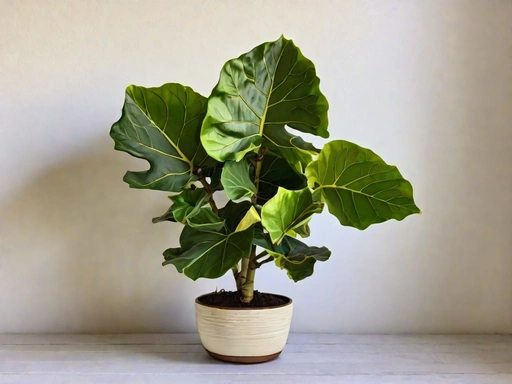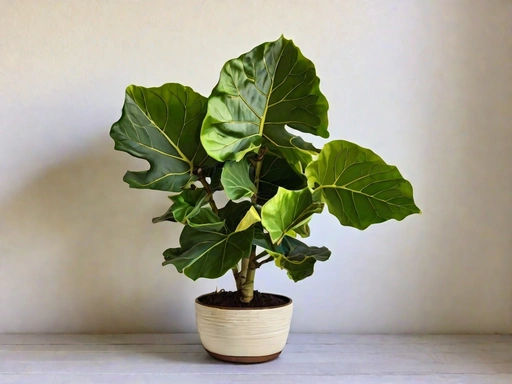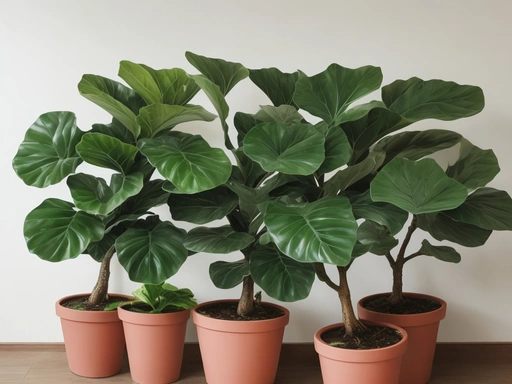Pet-Friendly Indoor Fiddle-Leaf Fig Care for a Thriving Green Oasis
Key Takeaways:
- Fiddle-leaf figs are a popular indoor plant choice and can be kept as pets-friendly household plants.
- Keep your indoor fiddle-leaf fig in a well-lit area, but avoid direct sunlight.
- Water your pet-friendly fiddle-leaf fig sparingly, allowing the indoor fiddle-leaf fign waterings.
- Regularly clean the leaves of your indoor fiddle-leaf fig to prevent dust buildup and ensure proper plant health.
Are you a proud pet parent who also loves to keep indoor plants? Well, look no further because today I’m here to talk about pet-friendly indoor fiddle-leaf fig care! This popular plant not only adds a touch of greenery to your living space but also ensures the safety of your furry friends.
In this article, we’ll dive into the basic characteristics of the fiddle-leaf fig, its pet-friendly qualities, and how to properly care for it, from watering and lighting to temperature and soil requirements.
So, grab a cozy spot with your pet by your side and let’s embark on this plant-loving journey together!
| Pet-friendly indoor Fiddle-leaf fig care | |
|---|---|
| Light | Indirect, bright light |
| Water | Allow the top inch of soil to dry out before watering |
| Temperature | 65-75°F (18-24°C) |
| Humidity | Moderate to high humidity |
| Fertilizer | Use a balanced, water-soluble fertilizer monthly during growing season |
| Pruning | Trim back leggy growth to encourage bushiness |
| Toxicity | Non-toxic to pets |
| Additional care | Dust the leaves regularly and rotate the plant for even growth |
Understanding the Fiddle-leaf Fig Plant
The Fiddle-leaf Fig Plant is a popular choice for indoor plants due to its distinctive large leaves and low maintenance requirements.
It adds a touch of greenery and elegance to any space.
Basic plant characteristics
The Fiddle-leaf Fig plant, scientifically known as Ficus lyrata, is a popular choice for indoor plant enthusiasts.
It features large, glossy, violin-shaped leaves that give it a unique and elegant appearance.
This plant can grow up to 10 feet tall and requires proper care to thrive.
It is important to understand its characteristics to provide the best possible care.
Popular indoor plant choice
The Fiddle-leaf Fig is a popular indoor plant choice because of its lush and attractive foliage.
It adds a touch of elegance to any room and is known for its air-purifying qualities.
Many people love how it makes a statement and brings a sense of nature and freshness into their homes.
It’s no wonder that it has become a favorite among plant enthusiasts and interior decorators alike.
Pet-Friendly Considerations for Fiddle-leaf Fig Care
When caring for a Fiddle-leaf Fig with pets in mind, consider toxic plants, pet-friendly characteristics, and safe placement.
Pet-friendly characteristics of the Fiddle-leaf Fig
The Fiddle-leaf Fig (Ficus lyrata) is considered to be pet-friendly.
It does not contain any toxic compounds that could harm cats or dogs if ingested.
However, it’s always a good idea to monitor your pets around the plant to ensure they don’t chew on the leaves, as this could still cause mild digestive upset.
Keeping the plant out of their reach is the best way to prevent any potential issues.
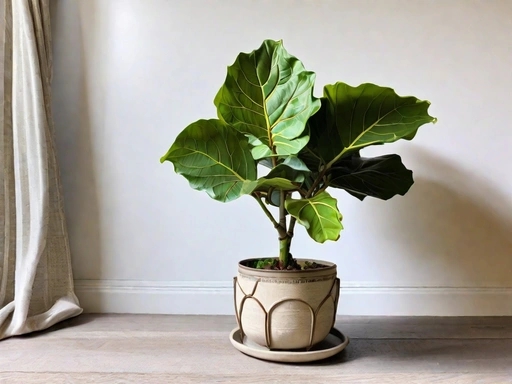
Safe placement of the plant
To ensure the safety of your pets, it’s important to place your Fiddle-leaf Fig plant in a location where they cannot easily access it. This means keeping it out of reach, whether that’s by placing it on a tall shelf, using hanging baskets, or using baby gates to create a barrier.
It’s also a good idea to avoid placing the plant in high-traffic areas where it could be knocked over.
Watering and Humidity Requirements
To care for your pet-friendly indoor fiddle-leaf fig, you’ll need to understand proper watering techniques and monitor humidity levels.
Understanding proper watering techniques
Proper watering is crucial for the health of your Fiddle-leaf Fig. It’s important to water the plant when the top inch of soil feels dry.
Avoid overwatering, as this can lead to root rot.
Use room temperature water and ensure that excess water drains out of the pot. Remember, consistency is key, so water consistently but avoid waterlogging the plant.
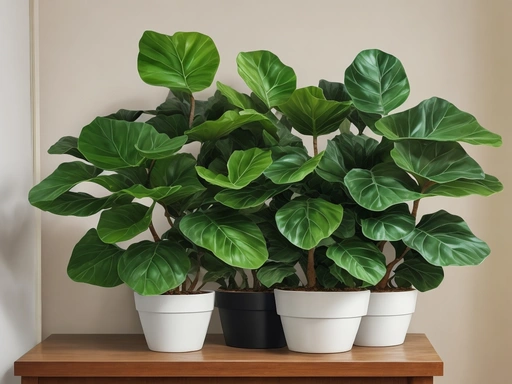
Monitoring humidity levels
Monitoring humidity levels is important for the health of your pet-friendly indoor Fiddle-leaf Fig plant. Use a hygrometer to measure humidity levels regularly.
Aim for a humidity level of 30-65%.
If the humidity is too low, consider using a humidifier or placing a tray of water near the plant. Avoiding excessive humidity is also important to prevent mold or rot.
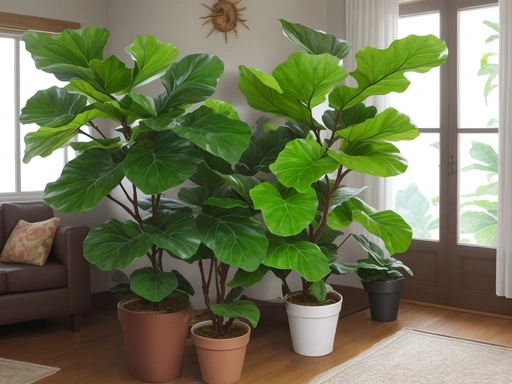
Mist vs. humidifier for increasing humidity
Mist and humidifiers are both effective for increasing humidity, but they have some differences.
Misting provides temporary moisture and can be done manually using a spray bottle.
Humidifiers, on the other hand, are electronic devices that release a continuous stream of moisture into the air.
They are more convenient for maintaining consistent humidity levels.
Choose the method that best fits your needs and preferences.
Lighting Needs for Indoor Fiddle-leaf Fig
The lighting needs of an indoor Fiddle-leaf Fig are important for its health and growth. Here’s how to ensure ideal light conditions and avoid direct sunlight.
Ideal light conditions for the plant
The Fiddle-leaf Fig plant thrives in bright, indirect light.
Place it near a window with filtered sunlight for optimal growth.
Avoid direct sunlight, as it can burn the leaves.
Consider supplementing with artificial lighting if natural light is limited.
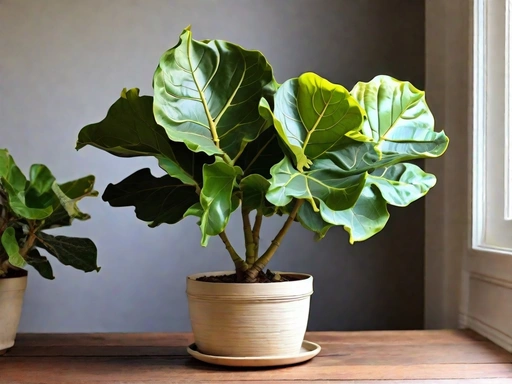
Avoiding direct sunlight
To avoid direct sunlight, place your indoor Fiddle-leaf Fig in a spot that receives bright, indirect light. Direct sunlight can cause the leaves to burn or fade.
Position the plant near a north or east-facing window or use sheer curtains to filter the light.
Supplementing with artificial lighting
To supplement with artificial lighting for your indoor Fiddle-leaf Fig, you can use full-spectrum LED grow lights.
These lights provide the right wavelengths of light necessary for plant growth.
Place the lights above the plant at a distance of 12-18 inches, and keep them on for 12-14 hours a day.
This helps compensate for insufficient natural light.
Remember to monitor the distance and duration to avoid burning the leaves.
Temperature and Ventilation Considerations
When caring for your indoor Fiddle-leaf fig, it’s important to consider optimal temperature range, avoiding drafts and temperature fluctuations, and providing adequate ventilation.
Optimal temperature range
The optimal temperature range for a Fiddle-leaf Fig plant is between 60-75°F (15-24°C).
It prefers a warm and stable environment, so avoid extreme temperature fluctuations.
Keep it away from drafty areas and direct heat sources like heaters or air conditioning vents.
Avoiding drafts and temperature fluctuations
To avoid drafts and temperature fluctuations, make sure to keep your Fiddle-leaf Fig away from windows, doors, and drafty areas.
These plants prefer stable temperatures, so try to maintain a consistent temperature range of 60-75°F (15-24°C).
Avoid placing your plant near heating or cooling vents, as sudden temperature changes can stress the plant.
Providing adequate ventilation
Proper ventilation is crucial for the health of your Fiddle-leaf Fig. Place your plant in a well-ventilated area with good air circulation.
You can achieve this by opening windows, using fans, or placing it near vents.
Avoid stagnant air and ensure fresh air flows around the plant.
Proper Soil and Fertilizer for Fiddle-leaf Fig
Choosing the right soil mix and fertilizing frequency and dosage are important for the proper care of your Fiddle-leaf Fig.
Understanding its nutritional requirements is key.
Choosing the right soil mix
Choosing the right soil mix for your Fiddle-leaf Fig is essential for its overall health and growth. Aim for a well-draining and aerated soil that retains some moisture.
A good mix can consist of equal parts of potting soil, perlite, and peat moss.
Avoid heavy soils that retain too much water.
Fertilizing frequency and dosage
Fertilize your Fiddle-leaf Fig every 4-6 weeks during the growing season (spring and summer) using a balanced liquid fertilizer. Dilute the fertilizer to half strength and water the plant until it drains out the bottom.
Avoid over-fertilizing as it can damage the plant.
Monitor the plant’s response and adjust the frequency if needed.
Nutritional requirements of the plant
The Fiddle-leaf Fig plant requires a balanced and rich nutritional diet.
It needs a fertilizer with equal amounts of nitrogen, phosphorus, and potassium.
You can use a slow-release balanced fertilizer or a liquid houseplant fertilizer diluted to half strength.
Avoid over-fertilizing, as it can lead to burned roots and leaf damage.
Pruning and Maintenance Tips
To maintain your pet-friendly indoor fiddle-leaf fig, focus on pruning for shape and size control, removing yellow or damaged leaves, and cleaning the leaves.
Pruning for shape and size control
Pruning is an essential part of caring for your Fiddle-leaf Fig. To control its shape and size, trim back any overgrown branches or stems with sharp, clean pruning shears.
Start by removing any dead or yellowing leaves, then selectively prune branches to encourage a more compact and bushy growth.
Regular pruning will help maintain a desirable shape and prevent your plant from becoming too leggy or unruly. Just remember to prune conservatively and not to remove more than 20% of the plant’s foliage at once to avoid stressing it.
Removing yellow or damaged leaves
To remove yellow or damaged leaves from your Fiddle-leaf Fig, simply use clean, sharp pruning shears to make a clean cut at the base of the leaf stem.
Make sure to remove any leaves that are completely yellow or brown, as they are no longer benefiting the plant.
Regularly checking and removing these leaves will help keep your plant healthy and maintain its appearance.
Cleaning the leaves
Cleaning the leaves of your Fiddle-leaf Fig is an important part of its care routine. Here are a few tips to keep in mind:
- Dust the leaves regularly: Gently wipe the leaves with a soft, damp cloth or feather duster to remove dust and keep them looking clean and shiny.
- Avoid using leaf shine products: While it may be tempting to use leaf shine sprays or polishes, these can actually clog the leaf pores and hinder the plant’s ability to absorb light and breathe.
- Be gentle: Fiddle-leaf Fig leaves are delicate, so be careful not to apply too much pressure or force when cleaning them. This could cause damage or leave visible marks.
- Check for pests: Cleaning the leaves also gives you the opportunity to inspect for any signs of pest infestations. Look for tiny insects, webbing, or discoloration, and take action if necessary.
Remember, a clean and healthy plant is a happy plant, so don’t neglect the leaves when caring for your Fiddle-leaf Fig.
Troubleshooting Common Issues
Troubleshooting common issues with your indoor Fiddle-leaf fig.
Brown spots and leaf drop
Brown spots and leaf drop in a Fiddle-leaf Fig can indicate several issues.
Overwatering is a common cause, so be careful not to water too frequently.
Dry air or low humidity levels can also lead to brown spots, so consider using a humidifier or misting the leaves.
Lastly, insufficient light can cause leaf drop, so make sure your plant gets enough indirect sunlight.
Pest infestations
Pest infestations can be a common issue with Fiddle-leaf Fig plants. There are several pests to watch out for, such as spider mites, mealybugs, and scale insects.
These pests can cause damage to the leaves, leading to yellowing, browning, and dropping.
If you notice any signs of pests, it’s important to take action quickly to prevent further infestation. Using insecticidal soap or neem oil can help control and eliminate these pests.
Regularly inspecting your plant and addressing any pest issues promptly will help ensure the health of your Fiddle-leaf Fig.
Root rot and overwatering signs
Root rot is a common issue caused by overwatering. Signs include yellow or wilted leaves, mushy or blackened roots, and a foul smell.
To prevent root rot, only water when the top inch of soil is dry and make sure the pot has drainage holes.
Frequently Asked Questions
Can I use a Fiddle-leaf Fig as a pet-safe alternative to toxic plants?
Yes, you can use a Fiddle-leaf Fig as a pet-safe alternative to toxic plants.
Fiddle-leaf Figs are non-toxic to dogs and cats, making them a safe choice for pet owners.
However, it’s always a good idea to monitor your pets and ensure they don’t chew on the leaves or consume large amounts of the plant, as mild digestive issues may still occur.
How often should I water my Fiddle-leaf Fig?
Water your Fiddle-leaf Fig when the top inch of the soil feels dry.
Stick your finger in the soil to check the moisture level.
Water thoroughly, allowing excess water to drain out.
Don’t overwater, as it can lead to root rot.
Aim for watering every 1-2 weeks, adjusting based on environmental factors and plant needs.
Is it normal for my plant to shed leaves?
Yes, it is normal for your plant to shed leaves. Plants naturally shed old or damaged leaves as part of their growth process.
As long as your plant is also producing new leaves, it should be fine.
However, if your plant is losing a large number of leaves or the shedding is accompanied by other signs of distress, it may indicate a problem that needs attention.
Can I propagate my Fiddle-leaf Fig?
Yes, you can propagate your Fiddle-leaf Fig! One common method is through stem cuttings. Simply cut a healthy stem just below a leaf node, remove the lower leaves, and place it in water or moist soil.
Another method is air layering, where you make a small cut in the stem and encourage new roots to form before separating it from the parent plant.
How tall can a Fiddle-leaf Fig grow indoors?
Indoor Fiddle-leaf Figs can grow up to 3-6 feet tall, but with proper care and conditions, they have been known to reach heights of over 10 feet.
The growth rate will depend on factors such as light, temperature, humidity, and overall care.
Final Verdict
The Fiddle-leaf Fig plant is a popular choice for indoor greenery, but it’s important to consider pet-friendly care.
By understanding toxic plants for pets and the safe characteristics of the Fiddle-leaf Fig, you can ensure a safe environment for your furry friends.
Proper watering techniques, monitoring humidity levels, providing adequate lighting, maintaining optimal temperature and ventilation, using the right soil mix and fertilizer, pruning for maintenance, and troubleshooting common issues will help you keep your pet-friendly Fiddle-leaf Fig thriving.
With these tips, you can create a pet-friendly oasis in your home while enjoying the beauty of this stunning plant.

